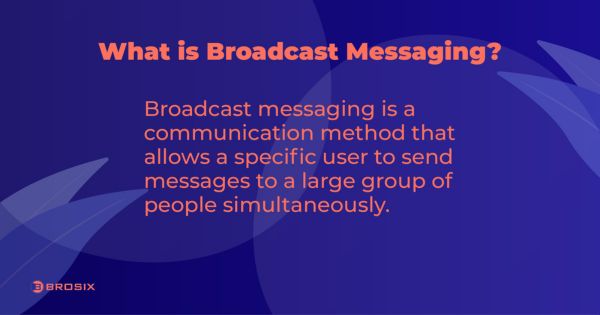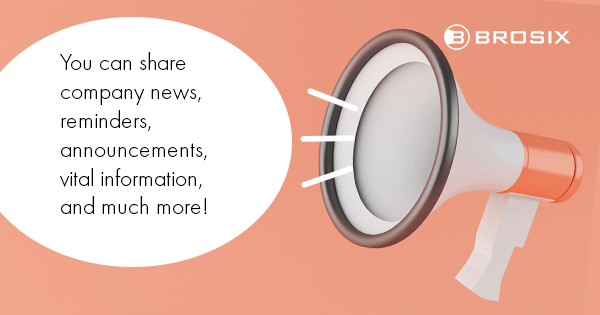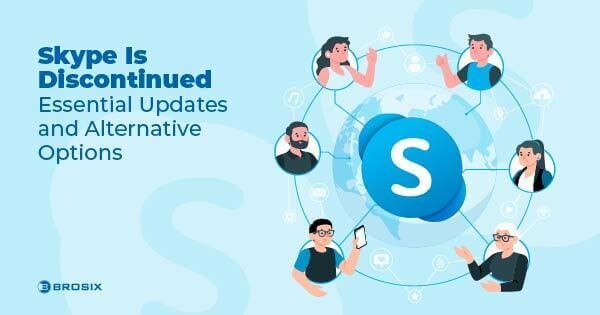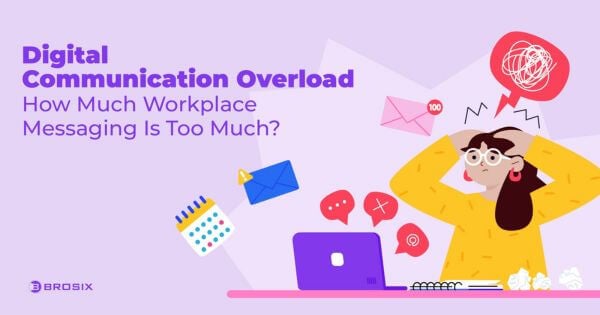Besides traditional marketing techniques, more and more companies nowadays rely on digital marketing methods. Not to mention the fact that digitalization is increasingly entering the workplace as well. News, updates, and announcements often need to reach multiple people at the same time. This is where broadcast messaging comes in handy.
So what is broadcast messaging exactly? Read on to find out more about its definition, types, how to use it with your team, prospects, and customers, and more.
Let’s get started.
What Is Broadcast Messaging?

Broadcast messaging is a communication method that allows a specific user to send messages to a large group of people simultaneously. The recipients, which can be hand-selected by the sender from his/her list of contacts, receive the message as a standard instant message (IM).
Businesses and organizations often send broadcast text messages to their customers and/or employees.
What differentiates this type of mass text from a standard SMS, MMS, or chat room message is that recipients can’t respond to it. Afterward, the message is recorded in the local chat history and the server history.
Types of Broadcast Messaging Service
There are different types of broadcast messaging services available. In a nutshell, they include sending SMS broadcast text messages, and message broadcasting through online instant messenger, email, and social media.
SMS broadcast messaging
SMS broadcast service provides you with the ability to send a text message to a wide audience. This allows businesses to send bulk SMS messages to multiple phone numbers at the same time. It’s also known as mass texting or group messaging.
Businesses can use broadcast text messaging services for marketing purposes to send out promotional messages, notify customers of recent service updates, ask them to participate in an SMS survey, etc. By implementing SMS marketing strategies, companies can effectively reach a large audience and personalize their messages. Text messages have higher open rates than emails, for example.
Additionally, text broadcast messaging services also support MMS messages, which enable the sending of multimedia content such as pictures or videos along with the text.
Email broadcast messaging
We won’t see an end to email marketing anytime soon. In fact, a recent study claims that 60% of consumers have made purchases after receiving an email marketing message. So email broadcast messaging seems to be a good investment for businesses.
It can be used for general announcements, advertising, event invitations, and newsletters. While effective at broadcasting information, such emails might miss the mark with personalization compared to targeted campaigns.
Social media broadcast messaging
This type of broadcast messaging involves sending messages to many people on different social media sites all at once.
To illustrate the concept better, let’s give you an example. If a restaurant chain wanted to announce a limited-time promotion, they could create a single post with an appealing image, caption, and call to action like “Tag a friend you’d like to share this with!”
Sharing the post simultaneously on all platforms—Facebook, Instagram, Twitter, and LinkedIn—enables the company to reach its audience quickly and engage them to pay a visit.
Broadcast messaging through an IM platform
Finally, you can use instant messaging apps such as WhatsApp, WeChat, and Slack to send messages to multiple users at the same time without allowing replies.
Moreover, you can send a broadcast message through Brosix, our instant messaging platform aimed at enhancing communication efforts within the team. We make it easy for your colleagues to receive messages containing essential information without disrupting their workflow.
How to Use Broadcast Messaging in Brosix?
With Brosix Instant Messenger, there are a number of ways to access Broadcast Message, and using the feature couldn’t be easier.
To access the feature through your contact list, simply click the “Broadcast Message” icon and select the individual contacts whom you wish to inform. You can then add and remove users from the “Selected Participants” list. Once you click “OK,” the “Broadcast Message” window appears, and all that remains is to compose your message and press “Send.” Once you send the message to the intended group of recipients, you’ll see the status change from “Sending” to “Sending Completed” at the bottom of the window.
You can also access Broadcast Message through a text chat or chat room window. In both windows, click the “Broadcast Message” icon and follow the same steps as you would when accessing the feature through your contact list. For further flexibility, you can access the feature through the Menu by clicking “Actions” and “Broadcast Message” and again following the previously mentioned steps. In all instances, recipients will not be able to respond to the broadcast message.
How Can It Help With Communication Efficiency?
A common argument against the use of texting and instant messaging in the workplace is that it can be a distraction. The truth is, though, that other means of communication—email and the phone—can also distract and interrupt.
Broadcast messaging is a powerful tool to overcome these inefficiencies. The benefits of broadcast messaging are manifold.
For starters, you can be sure that your message will reach all necessary participants more quickly and efficiently than other communication channels, such as email and phone. What’s more, with a broadcast message, recipients are traditionally unable to respond, eliminating any ambiguity that could leave the recipient wondering about how or what to answer, and that’s a time-waster. Moreover, by choosing to send a broadcast message, you’ll save yourself the effort of physically calling multiple individuals or composing an email and then sifting through inevitable responses that weren’t necessary in the first place.
Here are some common use cases for broadcast messages:
- It’s a colleague’s anniversary with the company, and everyone’s meeting to celebrate after work.
- You want to announce someone’s achievements and promotion.
- Your latest product is finally ready for launch.
- You’re going to be out of the office for an extended period of time, and you need to let your team know.
- Alert all parties involved that the upcoming project proposal is due.
At each of these events, by informing team members via a chat room, you provoke the possibility of a host of responses. And you’re no stranger to the game. A single message or funny comment provokes another and then another, and before you know it, a harmless announcement has become an office-wide group chat. And that’s a distraction.
But a broadcast message allows you to inform your team(s) simultaneously without any unnecessary replies or feedback. And by targeting specific individuals, you can avoid disrupting team members with news or information that doesn’t pertain to them. You could even send a message about an emergency and take precautionary or necessary measures.
Importantly, though, the total control Brosix provides its users extends to the Broadcast Message feature as well. By allowing administrators to handpick individuals who have access to the feature, the likelihood of spam or other inappropriate or malicious messages is greatly reduced, leading to a more efficient communication strategy.
All of this means you can share company news, appointment reminders, announcements, vital information, and much more.med.
Conclusion
Broadcast messaging takes advantage of channels like SMS, email, social media, and instant messaging to maximize attention while minimizing response clutter. The ability to easily share key information ensures that promotional offers, customer service updates, and current news reach the right people, ultimately improving customer relationships and teamwork.







